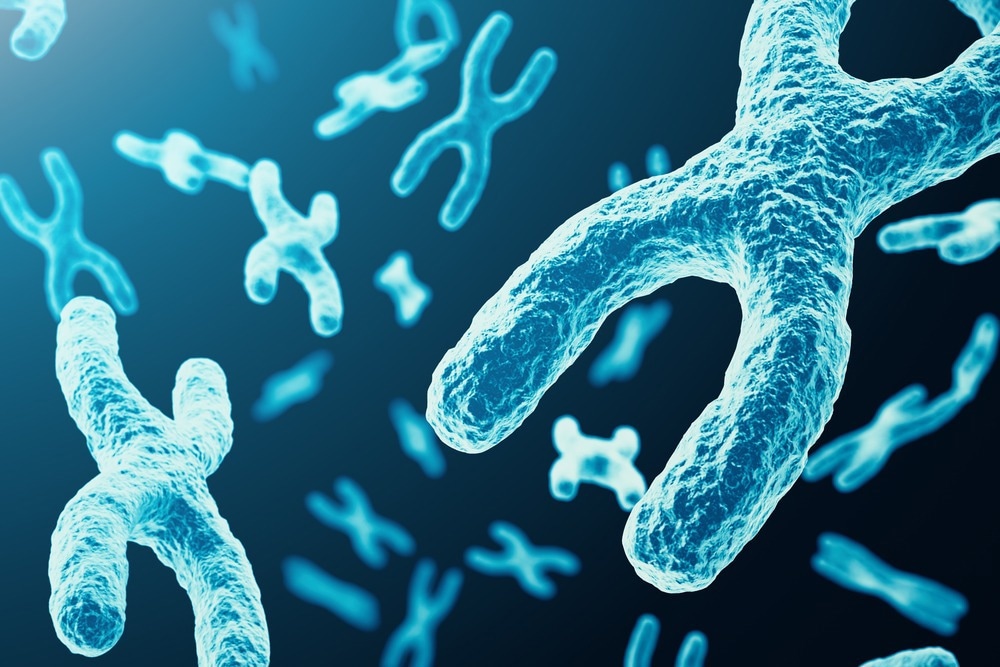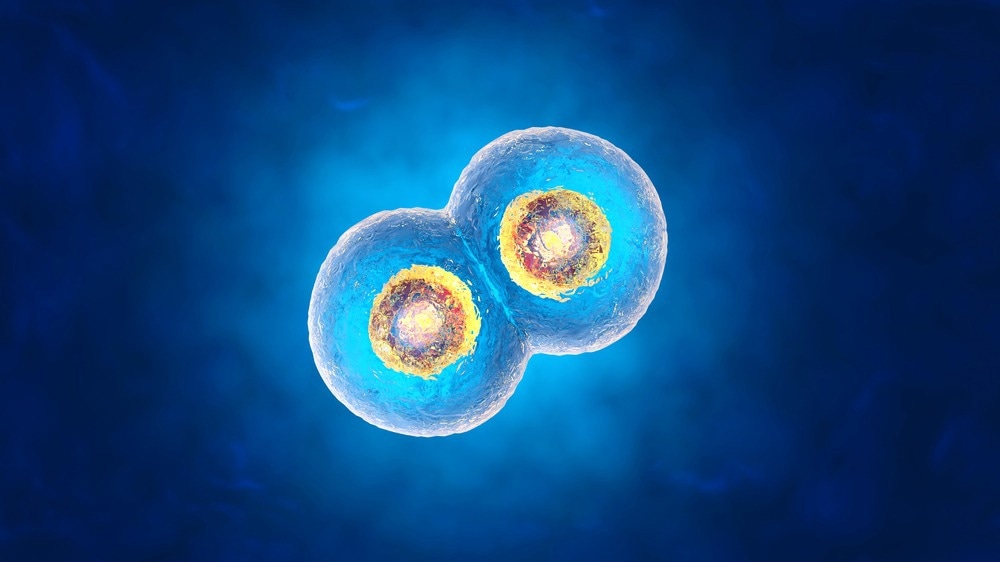The chromosomal passenger complex, which is formed from a kinase module (Aurora B), Borealin (also known as Dasra), scaffolding protein inner centromere protein (INCENP), and Survivin, is one of the highly conserved hetero-tetrameric complexes. The chromosomal passenger complex can orchestrate appropriate chromosome segregation with cytokinesis by targeting certain sites at various mitosis stages.

Image Credit: Rost9/Shutterstock.com
Composition and Structure of the Chromosomal Passenger Complex
Structural and biochemical studies showed that the chromosomal passenger complex is formed from a localization module (INCENP, Survivin, and Borealin (or Dasra)) and a kinase module (Aurora B) connected together by the central INCENP site. The INCENP N-terminal, survivin and borealin, which represent the localization module of the chromosomal passenger complex, are connected in a three-helix bundle, linking the baculovirus IAP repeat domain of surviving and the C-terminal of Dasra or Borealin, both of which are mandatory for proper localization to the chromosome centromere.
This localization module is also needed for appropriate localization of the complex to the mitotic spindles and anaphase midbodies, though the mechanism is not fully understood. The kinase module consists of Aurora B linked to the highly conserved IN-BOX at the INCENP C-terminal.
Recent studies showed that controlling chromosomal passenger complex localization and Aurora B kinase activity is also considered the main surveillance mechanism for the orderly mitotic exit. This guarantees the reestablishment of an effective interphase nucleus from condensed mitotic chromosomes by delaying mitotic exit and cytokinetic activity as a reaction to a defect in the segregation of chromosomes.
The Chromosomal Passenger Complex Role in Interphase and Mitosis
Few studies have inspected the role of chromosomal passenger complex during interphase because interrupting the complex led to evident and substantial defects during mitosis. However, a recent study performed by Hayashi-Takanaka and colleagues suggested that temporary inhibition of Aurora B during interphase results in the missegregation of chromosomes in the subsequent mitosis. This points out that the chromosomal passenger complex has important functions before the entry of mitosis.
During the late S phase, the chromosomal passenger complex can be first visualized on pericentromeric heterochromatin in vertebrate cultured cells. Chromosomal passenger complex targeting to heterochromatin includes heterochromatin protein 1 binding to a PXVXL/I (Pro-X-Val-X-Leu/Ile) motif in INCENP. A heterochromatin protein 1 ‑binding site mutant on INCENP did not localize to heterochromatin during interphase but led to no mitotic defect in HeLa cell line.
There is a close association between a fraction of heterochromatin protein and centromeres in interphase because of interaction with Mis-14, a part of the Mis-12 kinetochore complex, which has a role in the binding of microtubules through the KMN network (an essential microtubule-binding module of the outer kinetochore that comprises the KNL-1, Mis-12 and Ndc-80 complexe).

Image Credit: Spectral-Design/Shutterstock.com
Although the Mis-14– heterochromatin protein 1 interaction can be seen only during interphase, it is essential for centromeric enrichment of the chromosomal passenger complex in HeLa cell line during mitosis. Therefore, the Mis-14– heterochromatin protein 1 interaction could help in chromosomal passenger complex recruitment to the inner centromere before mitosis. Enrichment of the centromere of the chromosomal passenger complex during mitosis does not depend on the underlying DNA sequence but instead needs the mitosis-specific-phosphorylation of two histone tails.
Aurora B kinase activity has a role in various feedback loops, facilitating the quick and spatially restricted recruitment of the chromosomal passenger complex to the centromeres. Aurora B catalyzes phosphorylation of H3S10, which is a classical epigenetic sign of mitotic chromosomes. Depletion of INCENP results in a remarkable decline in the phosphorylated H3S10 level in vitro and in vivo. The relationship between phosphorylation of H3S10 and mitotic chromosome compaction has been studied in detail; however, although this modification contributes to chromosome compaction during anaphase in budding yeast, its role in higher eukaryotes is still not fully understood.
The role of the chromosomal passenger complex that starts from the chromosomes finally ends at the central spindles and the midbodies, where it performs its function in late mitosis, including anaphase spindle stabilization, anaphase chromatid compaction, and cytokinesis. Removal of the chromosomal passenger complex from the chromosome is also needed to reform the nucleus and to facilitate mitotic exit.
The shifting of the chromosomal passenger complex from interaction with chromatin and the kinetochores in early mitosis to the regulation of cytoskeletal processes during mitotic exit points out the clear evidence of the original chromosomal passenger complex hypothesis. This sophisticated, transiently, and spatially regulated signaling module sends and receives signals from both chromatin and cytoskeletal parts. It could make small adjustments to the highly local protein to protein interaction while simultaneously regulating the total effect of the spindle assembly checkpoint.
Sources:
- Kitagawa, Mayumi, and Sang Hyun Lee. (2015) The chromosomal passenger complex (CPC) as a key orchestrator of orderly mitotic exit and cytokinesis. Frontiers in cell and developmental biology 3, p. 14. https://pubmed.ncbi.nlm.nih.gov/25798441/
- Ruchaud, Sandrine, Mar Carmena, and William C. Earnshaw. (2007) Chromosomal passengers: conducting cell division. Nature reviews Molecular cell biology, 8(10), pp. 798-812. https://pubmed.ncbi.nlm.nih.gov/17848966/
- Carmena, Mar, et al. (2012) The chromosomal passenger complex (CPC): from easy rider to the godfather of mitosis. Nature reviews Molecular cell biology, 13(12), pp. 789-803.
- Hayashi-Takanaka, Yoko, et al. (2009) Visualizing histone modifications in living cells: spatiotemporal dynamics of H3 phosphorylation during interphase. Journal of Cell Biology, 187(6), pp. 781-790. https://pubmed.ncbi.nlm.nih.gov/19995936/
- Kiyomitsu, Tomomi, et al. (2010) Inner centromere formation requires hMis14, a trident kinetochore protein that specifically recruits HP1 to human chromosomes. Journal of Cell Biology, 188(6), pp. 791-807. rupress.org/.../Inner-centromere-formation-requires-hMis14-a
Further Reading
Last Updated: May 31, 2023